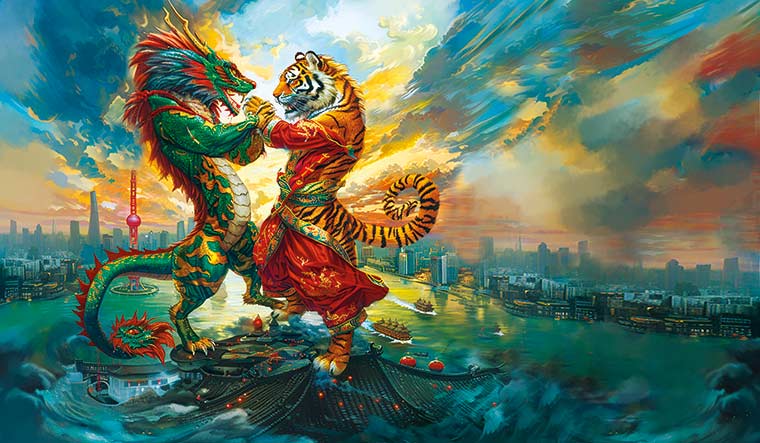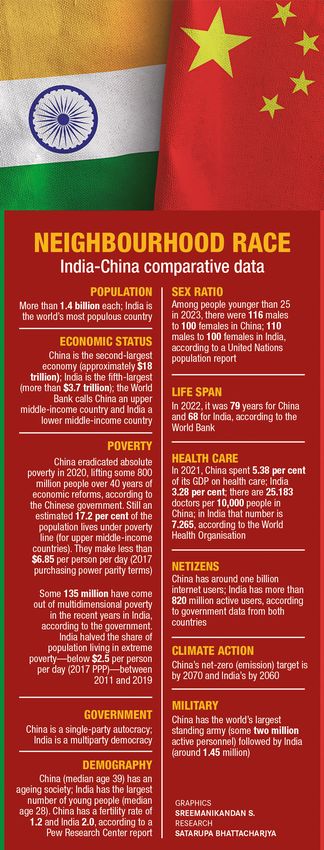China aspires to replace the United States in the global order. India, a rising geopolitical and economic power, has drawn closer to the US amid Chinese assertions, especially in South Asia. India seeks to maintain foreign policy autonomy, but strategic concerns have placed it at odds with China.
The neighbours across the Himalayas are the world’s only “population billionaires”. Trade and cultural links go back centuries. Yet, a modern-day reality is the decades-long border dispute that last killed soldiers on both sides in 2020. The differences run deep. China is a one-party autocracy. India is a multiparty democracy.
The BJP and the Communist Party of China (CPC) claim to be the world’s largest political outfits by membership. Both are nationalistic and cadre-based, but their politics vary.
This cover package looks at the complexities of Sino-Indian diplomacy; the two armed forces, from training to technology; the growth of bilateral commerce and the need for a “bold” trade deal with China; the state of civil liberties in China and the lessons for India; the interconnectedness of ancient Sino-Indian history, and the soft power the countries wield in the modern world; and compares the advances they have made in science, technology and innovation.
China and India offer contrasting examples of demographic transition towards longer lives and smaller families, a 2023 UN report said. The average life span in China has increased. But it is an ageing society, a fallout from the past one-child policy. While India is the most populous country, with a youthful population, the workforce will need to grow and train to take on China’s manufacturing prowess in the future, aside from setting up the infrastructure.
In China, there are many more women in factories and on farms, and as drivers of public transport and in corporate boardrooms. India has more women in leadership roles in politics and government (a result of the independence movement), although the number is small compared with the European Union. The CPC has never had a woman on the standing committee, its top decision-making body.
Same-sex marriage is not legal in China or India. Transgender is recognised as a gender identity in Indian government documents, such as passports. The LGBTQ+ community is invisible in popular culture in China, although the country decriminalised homosexuality two decades ahead of India. Society in China is conservative in some ways, liberal in others. Both countries are deeply patriarchal.
 Future perfect: Visitors interact with a robot at the Mobile World Congress in Shanghai on June 26, 2024 | AFP
Future perfect: Visitors interact with a robot at the Mobile World Congress in Shanghai on June 26, 2024 | AFP
Over 40 years, China relentlessly built infrastructure. Tunnels were dug through mountains and under the sea; there are highways over land and water; ports and airports even in remote areas; and roads nearly everywhere. Alongside sprouted ghost towns―empty buildings, a byproduct of the real estate boom before crisis hit the sector.
China has the world’s largest high-speed rail network (more than 40,000 kilometres). Even if flights are delayed, the high-speed trains are almost always on the dot. The country has modernised agriculture and makes nearly every item of use, from toothbrushes to rockets. But now it needs to move from export-oriented manufacturing to high-value services, and from investment to consumption. It has overcapacity in steel and iron, and, like India, uses a lot of coal, but has invested much more in renewable energy. China has the most digital citizens, followed by India. But the Chinese internet has greater speed and reach.
China has the largest number of movie screens (80,000 in 2021). The mainland’s newer films tend to be patriotic, not the old cinematic fare of directors such as Zhang Yimou. The country still produces world-class musicians and wins big at the Olympics. Elderly Chinese women and men still like to go square-dancing after dinner.
The CPC is many things, an iron-fisted ruler over seven decades at home, a “wolf warrior” or a tai chi master on the world stage, depending on your view, and even paternalistic in formulating policy. But its centralised, top-down approach was put to good use in ending absolute poverty in 2020, according to some experts who also said, local governments deliver public services more efficiently in China. But state governments enjoy more freedom to make decisions in India.
Despite the “authoritarian stability”, government debt in China has ballooned. Victor Shih, a China expert and professor of political science at the University of California, San Diego, said local governments had accumulated huge amounts of debt, “estimated to be 90-110 per cent of the GDP”, both because of a massive amount of infrastructure spending from 2009 to 2015 and the economic downturn during the pandemic. “Once debt is created, even a strong state would find it challenging to digest it over time, especially given the lower growth trajectory. The only ways to digest the debt include inflating it away or dramatically reducing expenditures, both of which contain risks,” he said.
At the end of 2023, local government debt in China was more than 40 trillion yuan ($5.5 trillion), according to official data. The central government has issued guidelines to rein in the record debt amid worries of its impact on the economy.
Some foreign proponents of China’s development model, including expat Indians, have argued that a country as populous as China could not have achieved high growth year after year without authoritarian governance. So, a question that is relevant to India, arises. Can rapid economic development and democratic politics coexist in a developing country of 1.4 billion people?
Shih said economic development and democracy could coexist but the economic cycles were likely to be more pronounced. China’s legacy of a large state sector―which India also has to an extent―allows state-owned enterprises to step in with investment and employment during economic downturns. “The trade-off of not allowing recessions to take place is that businesses and governments take excessive risks and borrow way beyond their means. As we see today, that has become a major challenge in China,” said Shih.
Also Read
- Bilateral diplomacy is a never-ending tightrope walk for India and China
- China is ahead in military might, but India is catching up fast
- India must take a leaf out of China's cultural diplomacy and strengthen research on Beijing
- Both India and China use soft power to influence global opinion
- There has never been a better time to pursue a trade deal with China
- China has witnessed a vigorous crushing of civil liberties over the past decade
Activists have long alleged that China’s development has come at a cost: human freedoms. Historically, civil liberties have been fragile in China, from the imperial times to the Kuomintang rule to the Mao era, with a window in between, until that was tightly shut again in the past decade. Rana Mitter, a China expert and professor of US-Asia relations at Harvard University, said the room for open academic discussion was narrower today than it was 10 or 20 years ago. “This matters, as China needs a lively and rich public sphere to navigate so many of the issues that will shape it in the next few years―economic slowdown, demographic shifts, new technology and its impacts. China has always thrived when it is at its most open,” said Mitter. “And at the moment, difficult topics are harder to address in the public sphere.”
The author is a journalist with a decade-long experience in China.




